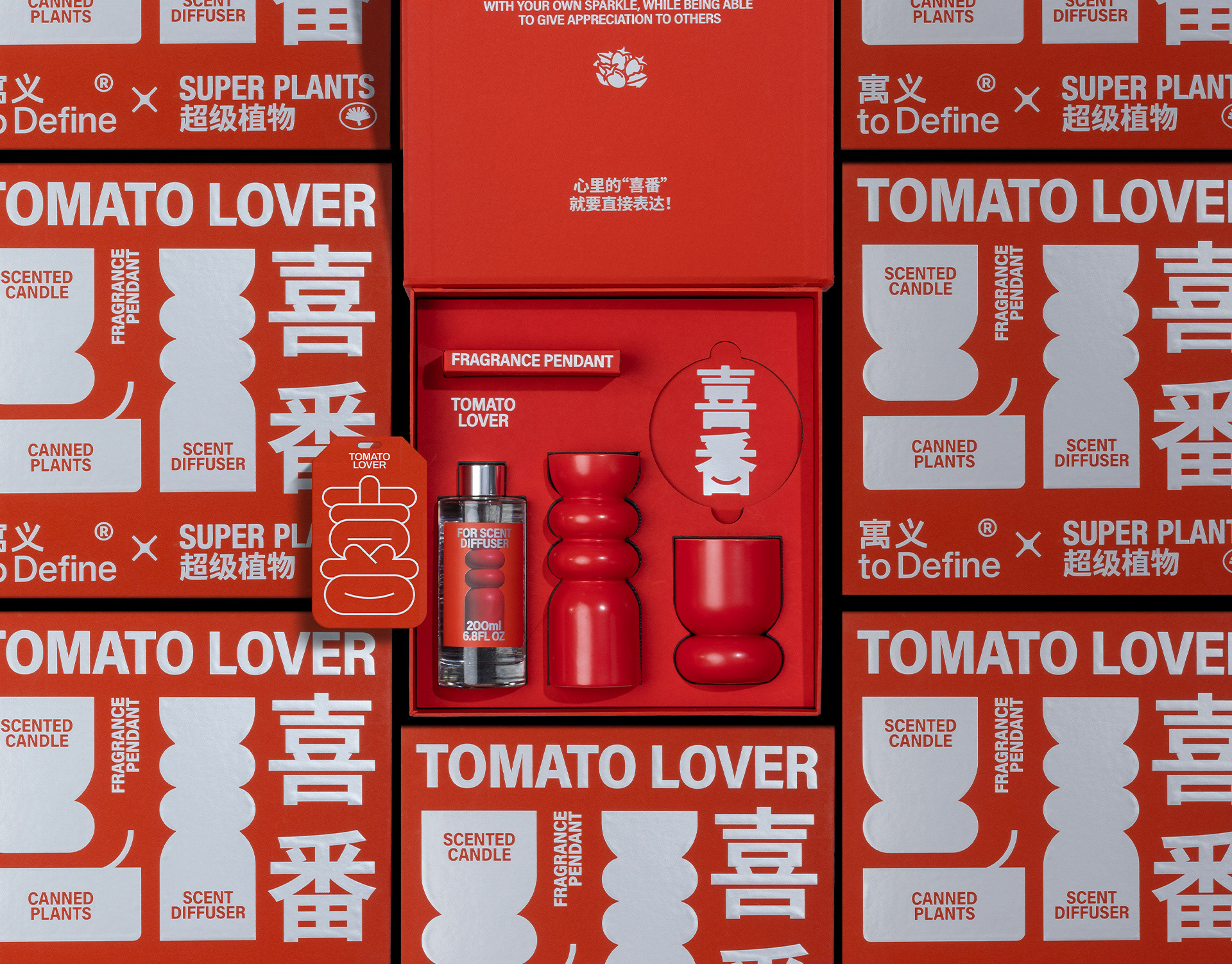
THESIS STATEMENT
How can a symbol system used on plant & seed packaging help consumers make in-the-moment decisions about purchasing plants to keep near their pets, and how can an app work in conjunction to aid in plant identification in a variety of situations?
BACKGROUND
This thesis project emerged from a deeply personal part of me, as I have two cats of my own and have been interested in gardening since I moved out of my parents' home. The experiences I faced trying to navigate the vast internet led me to consider what could make the journey to research pet-safe plants easier for myself as well as others.



screenshots taken from Google and the ASPCA website, the latter of which is severely underdeveloped
Faced with over 21 million results in .5 seconds after a Google search looking for what plants are toxic to cats, I wished to find all the information I could in one concise location. Unfortunately, whether it came to existing apps or various academic websites, one source was always missing something that another had. The ASPCA, or American Society for Prevention of Cruelty to Animals, was specifically referenced in many sites I sourced. While their archive is expansive, the information is terribly lacking compared to other academic sources. I decided to use this organization as the foundation for my thesis to improve upon their archive and create the concise database that I was looking for.
GOALS & AUDIENCE
The decision to design an app prototype rather than a book or website was so I could utilize the features specific to handheld devices such as the camera and ease of making updates. I wanted the app to meet the needs of a variety of audiences from pet owners looking to buy plants, to plant owners bringing in a pet, to those who have neither but want to be considerate when buying plants for those who do have animals. This meant planning for a variety of potential situations in which users may interact with the archive.
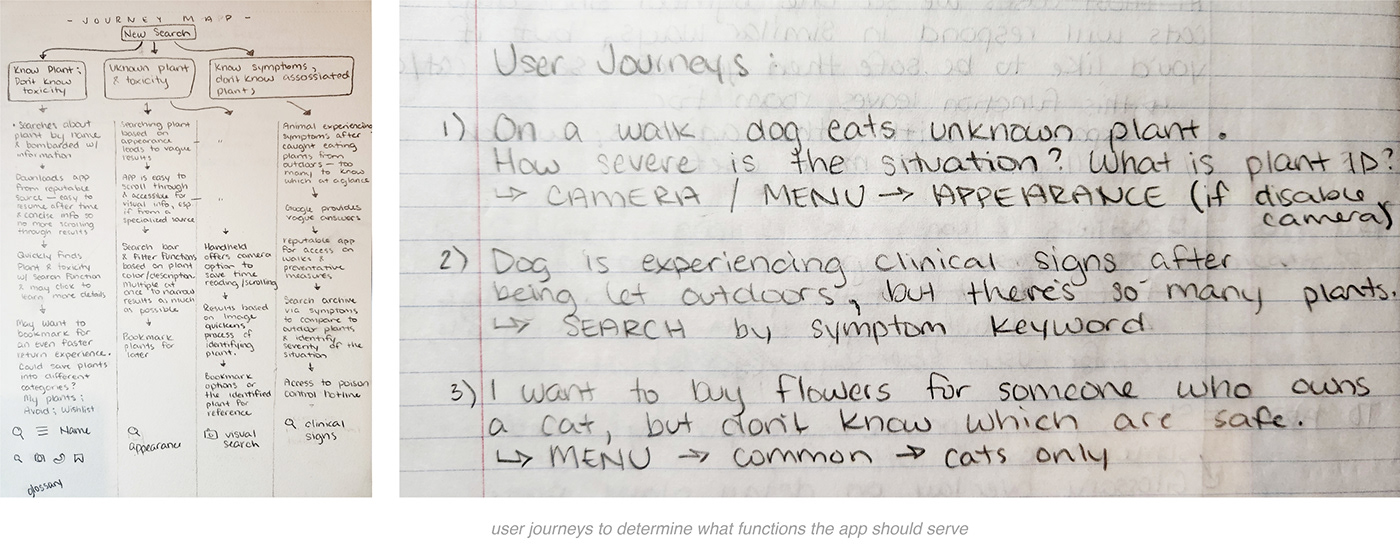
In addition to digital interactions, I wanted to consider in-store interactions with plants and the potential danger of spontaneous plant purchases. This led to the decision to create a symbol system to represent the effects a plant may have if eaten by a cat or dog, with the intention to be printed on seed packets, plant tags, or placed on pots as stickers.
DESIGNING A SYMBOL SYSTEM
The symbol system is where I decided to start my process, as I knew I would eventually bring it into the app prototype. I thought a binary route was the way to go, taking inspiration from a variety of rating systems for movies and more. At first I wanted to bring a stylistic touch to the symbols and researched how the Olympic Games icon system visually changed every few years despite being the same content.
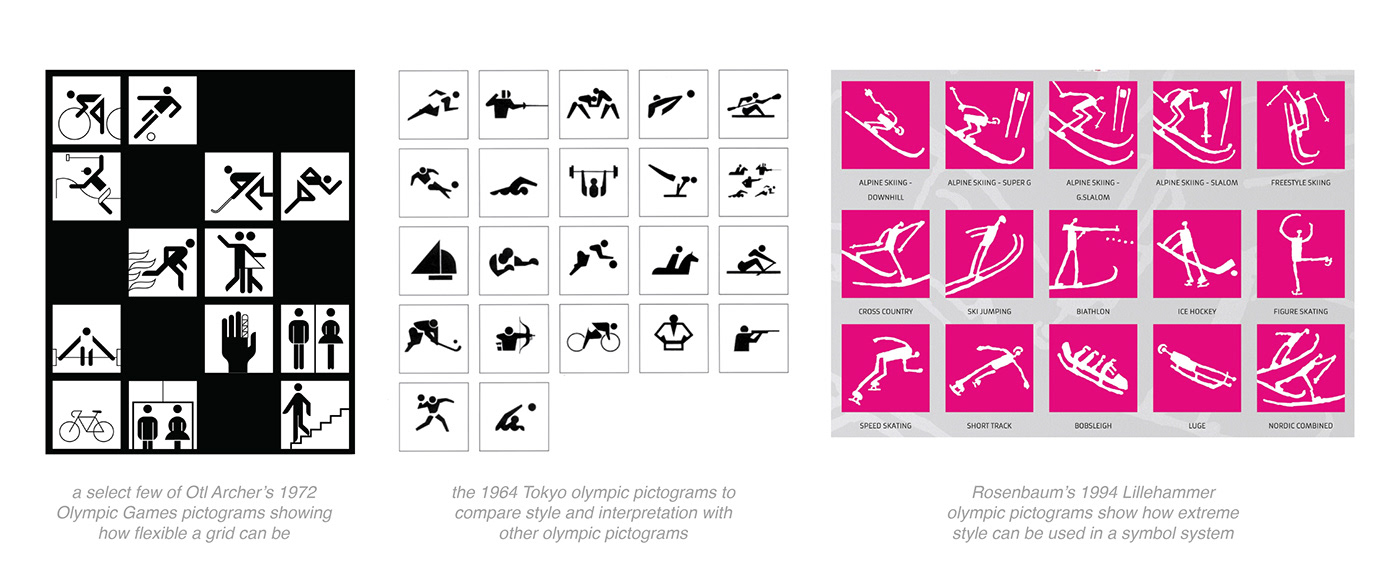
I also considered whether the animals should show emotion to reflect the state of toxicity, or if symbols of the animals experiencing symptoms had a place in the system. I was inspired toward this direction by a system of symbols created by the Queensland Government for plants toxic to humans.



In the end, I used both animal expressions and representations of symptoms, then diverted from a five-step binary system to three steps to simply show whether a plant would be safe, sickly, or deadly to cats & dogs.
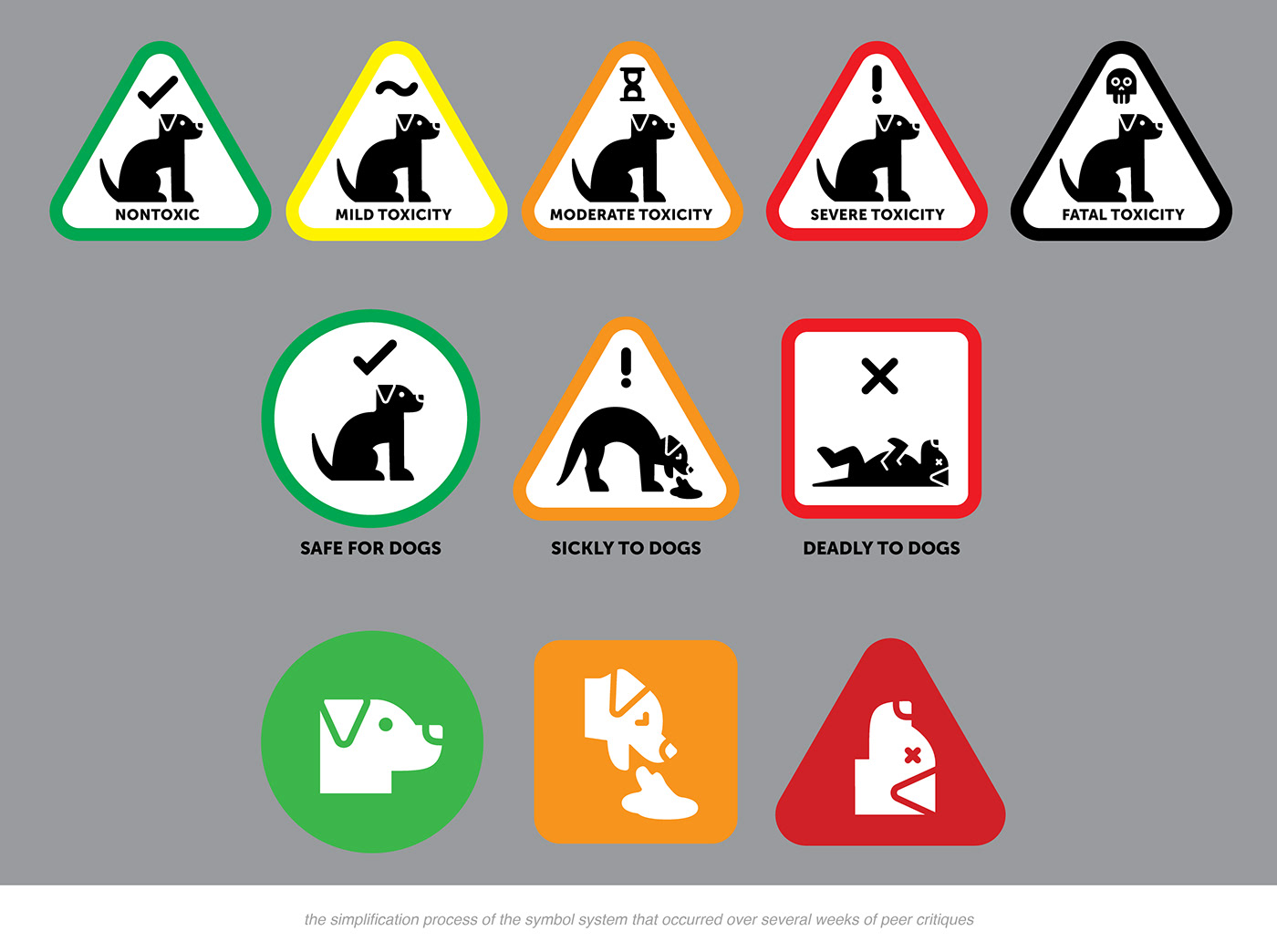
The final plant toxicity symbol system consists of six symbols—three for cats and three for dogs—with a few notable design differences for maximum universality. The first symbols are green and circular in shape, with a neutral animal position to translate the plant has no effect or is safe. The next set is orange and square, with a dog or cat vomiting to show that plants with this icon will make your pet sick. This symbol covers the widest range of symptoms. Lastly, the red triangle symbol depicts a cat and dog lying down—deceased—to show the most tragic of consequences if the plant is consumed.
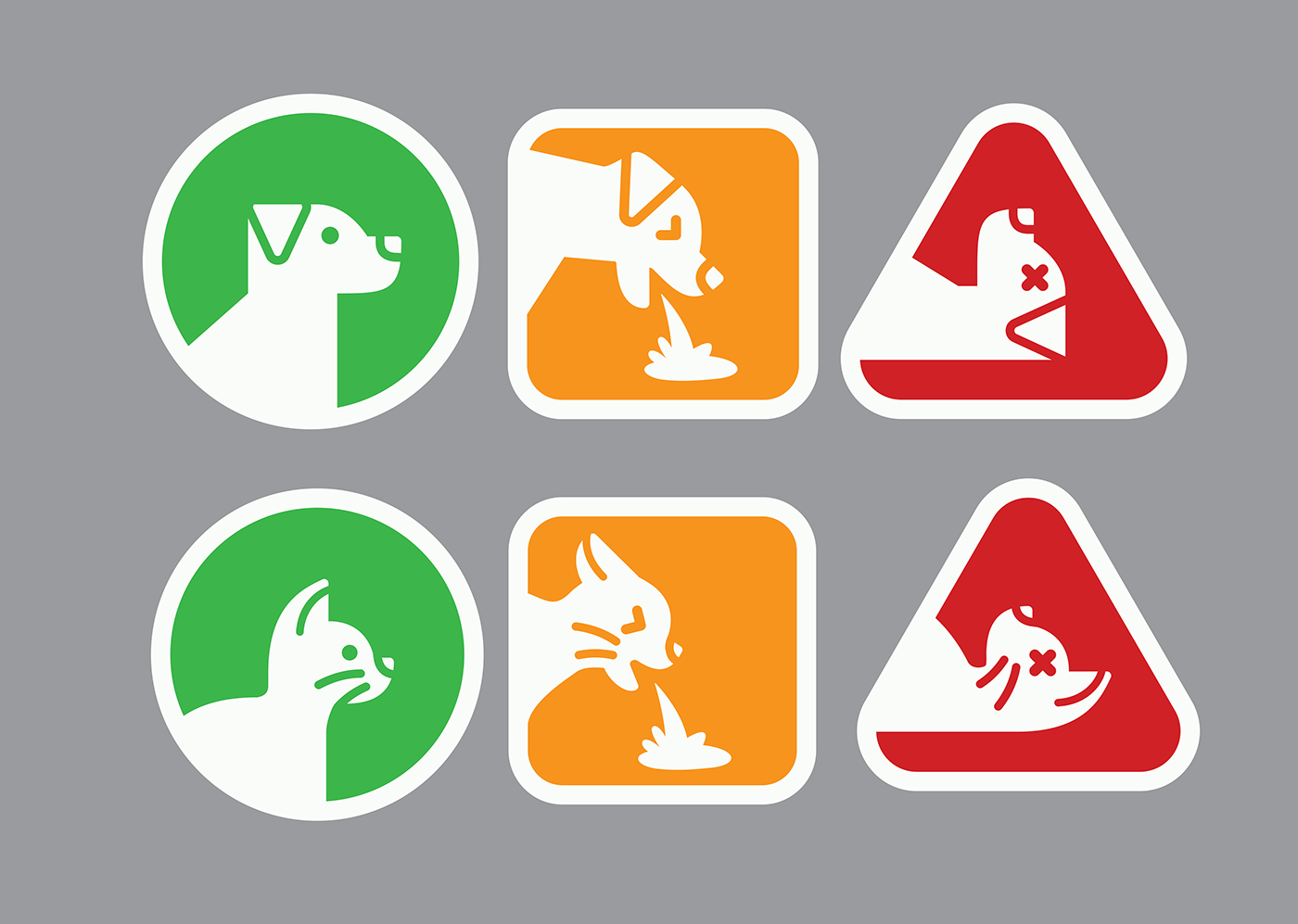
full finalized symbol system
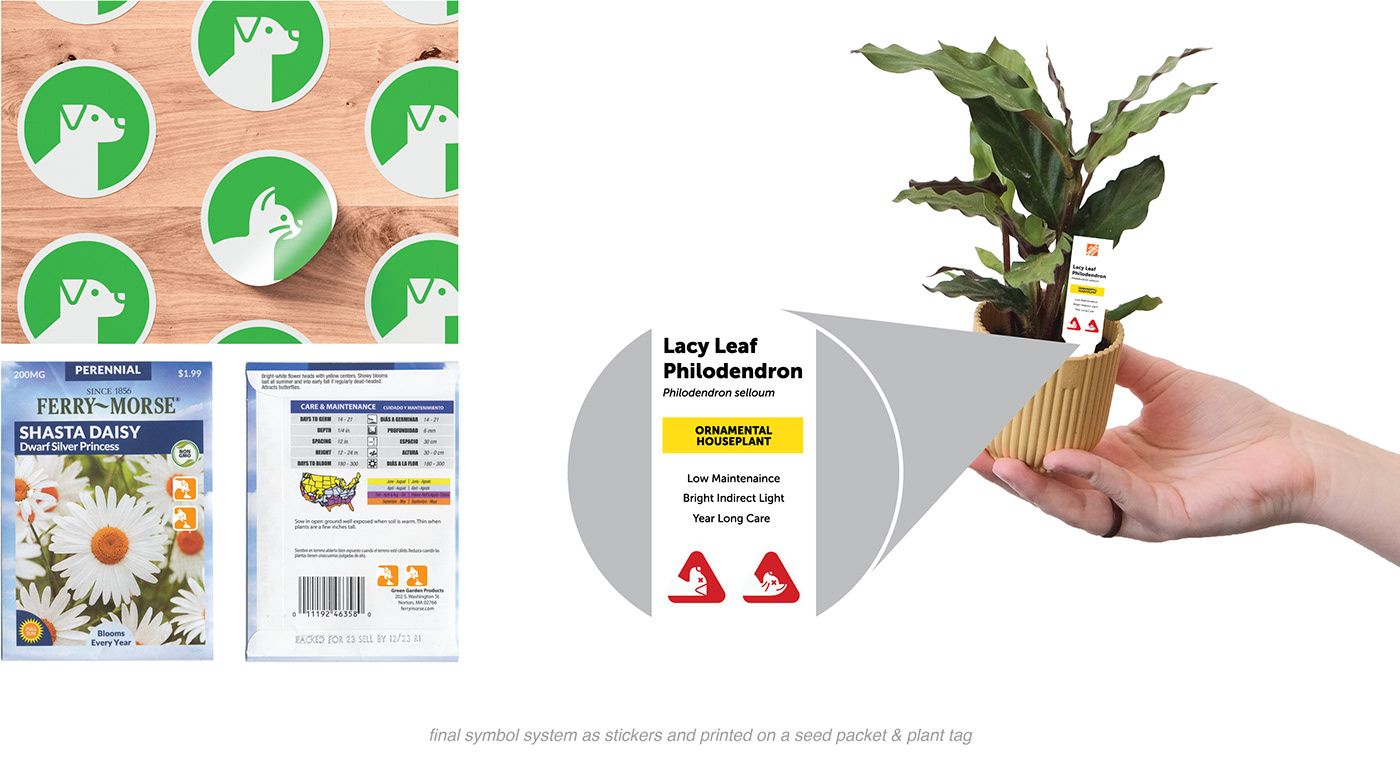
DESIGNING AN APP
The design of my plant toxin archive app began with hand drawn wireframes to meet the needs of the previously mentioned user journeys and expand to fill gaps left by similar, existing apps. I referenced a variety of popular apps to grasp standards in User Experience, as well as set a foundation for my own user interface that would fit under the ASPCA’s umbrella.
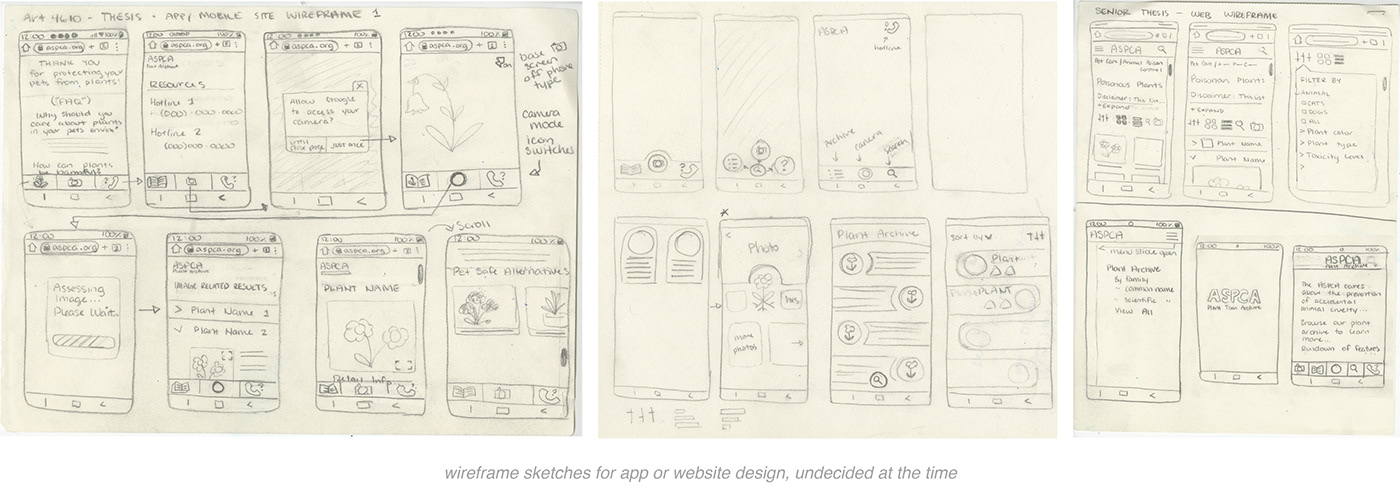
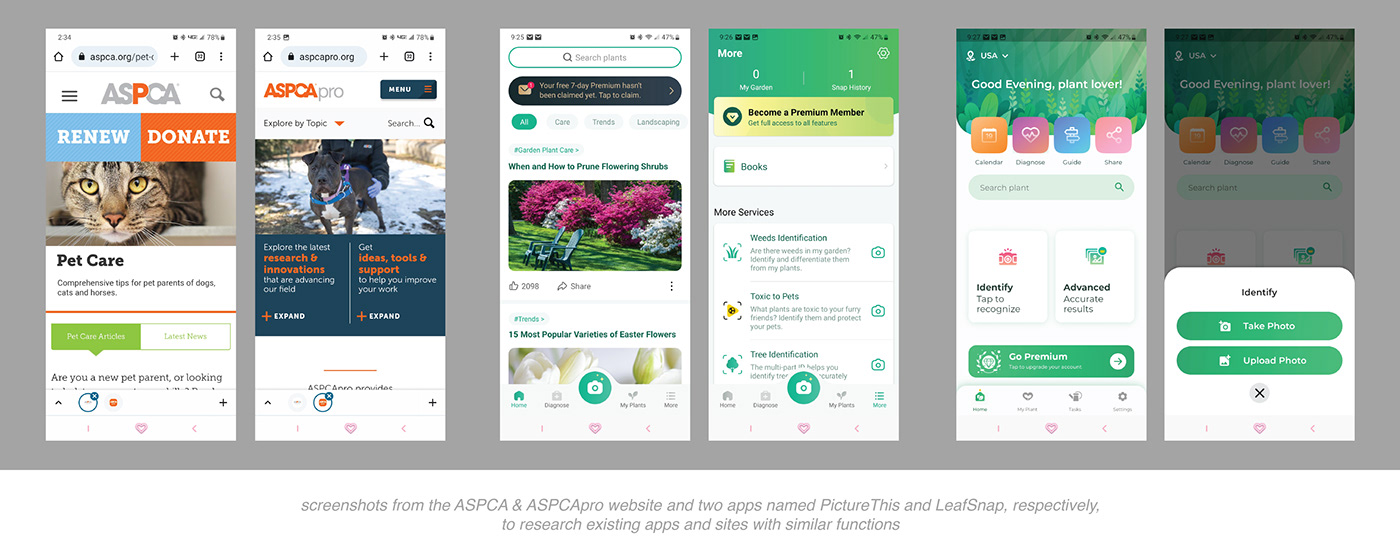
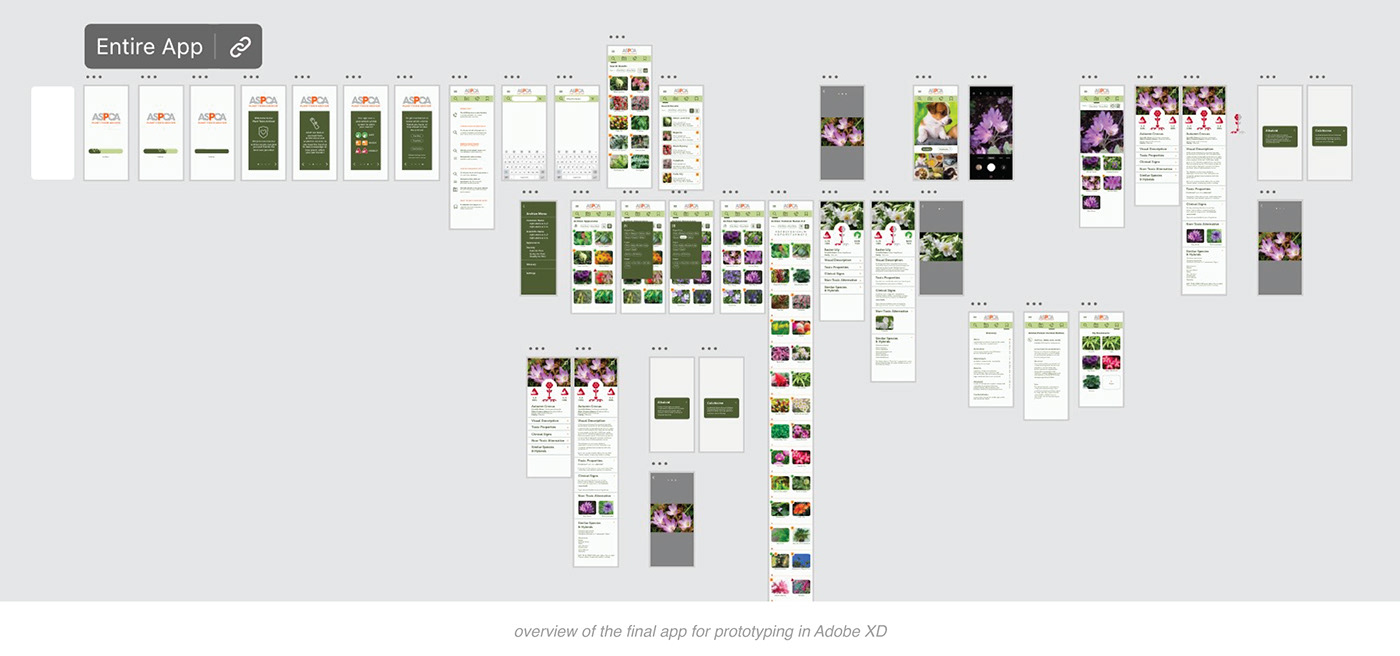
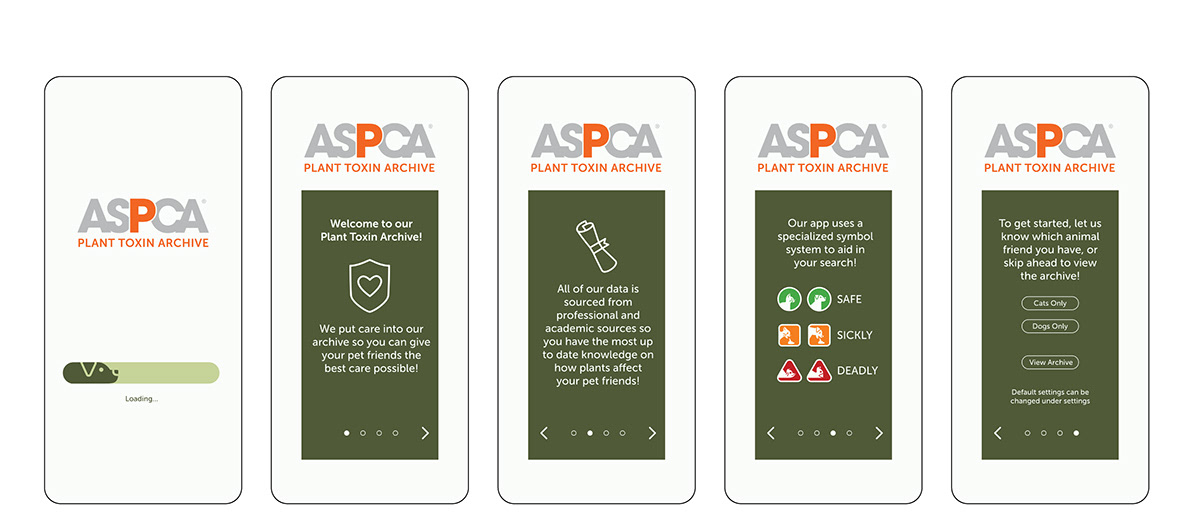
loading screen and onboarding system introducing ASPCA brand and quick guide to the symbol system
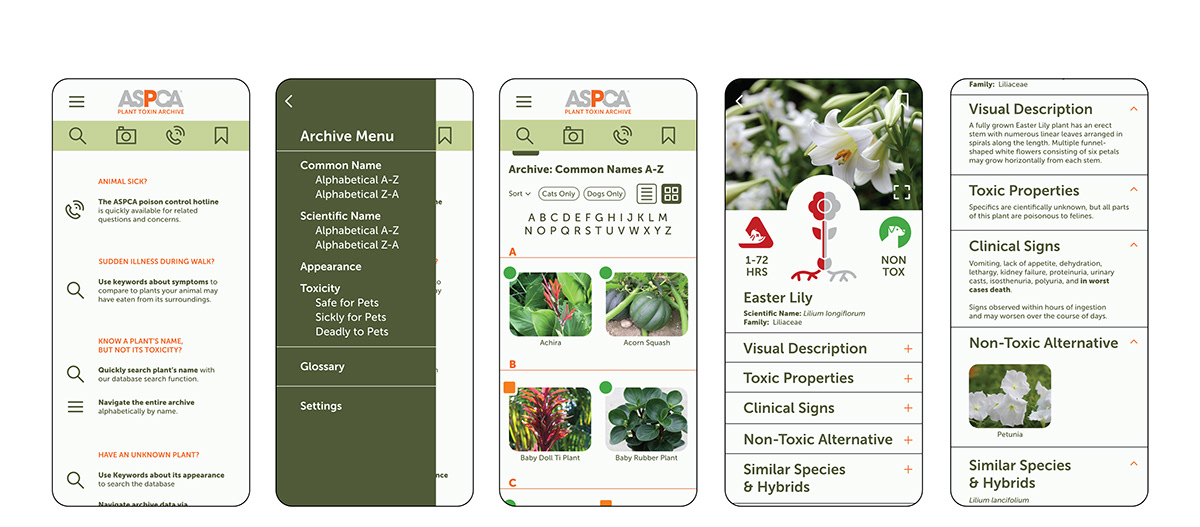
user journey: browsing the archive by common name to to better educate oneself on which plants are safe or not
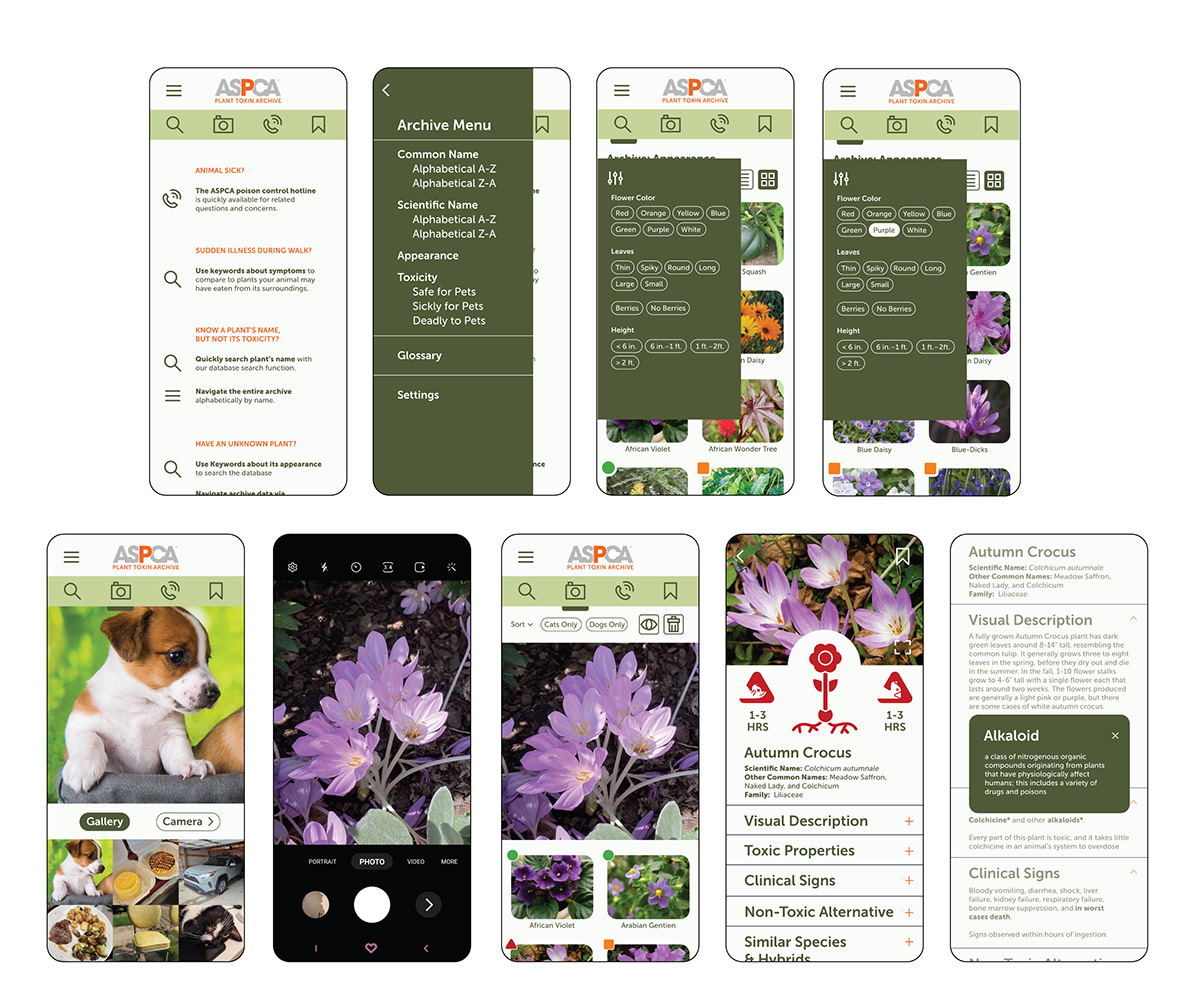
user journey: dog eats an unknown plant while on a walk; options are to use a photograph for a visual archive search or manually select appearance filters if camera access is denied
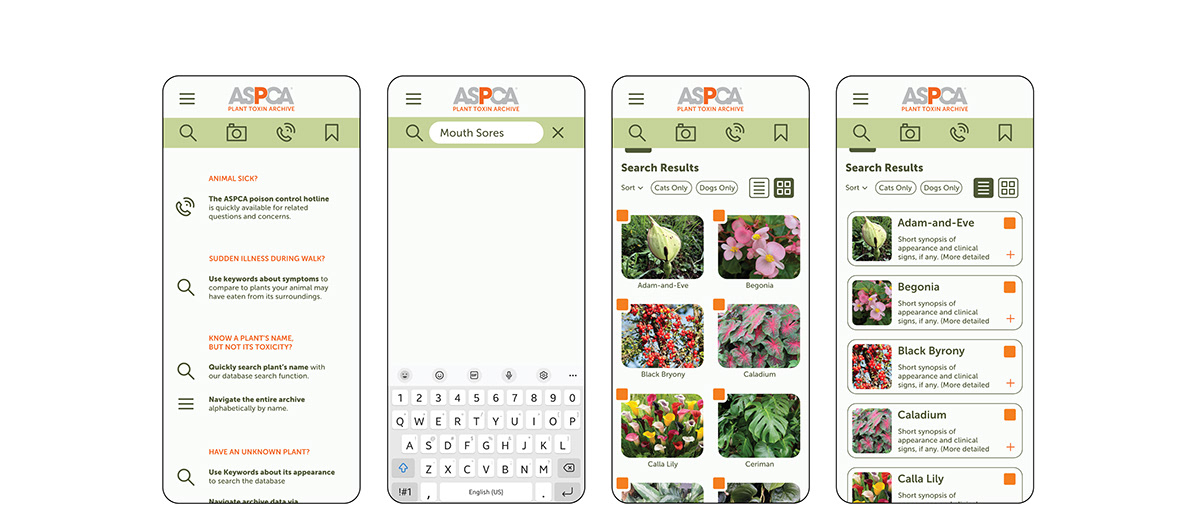
user journey: pet returns from a backyard bathroom break with mouth sores, and you're unsure which plant it may have eaten from the garden
Adobe XD prototype of the ASPCA Plant Toxin Archive
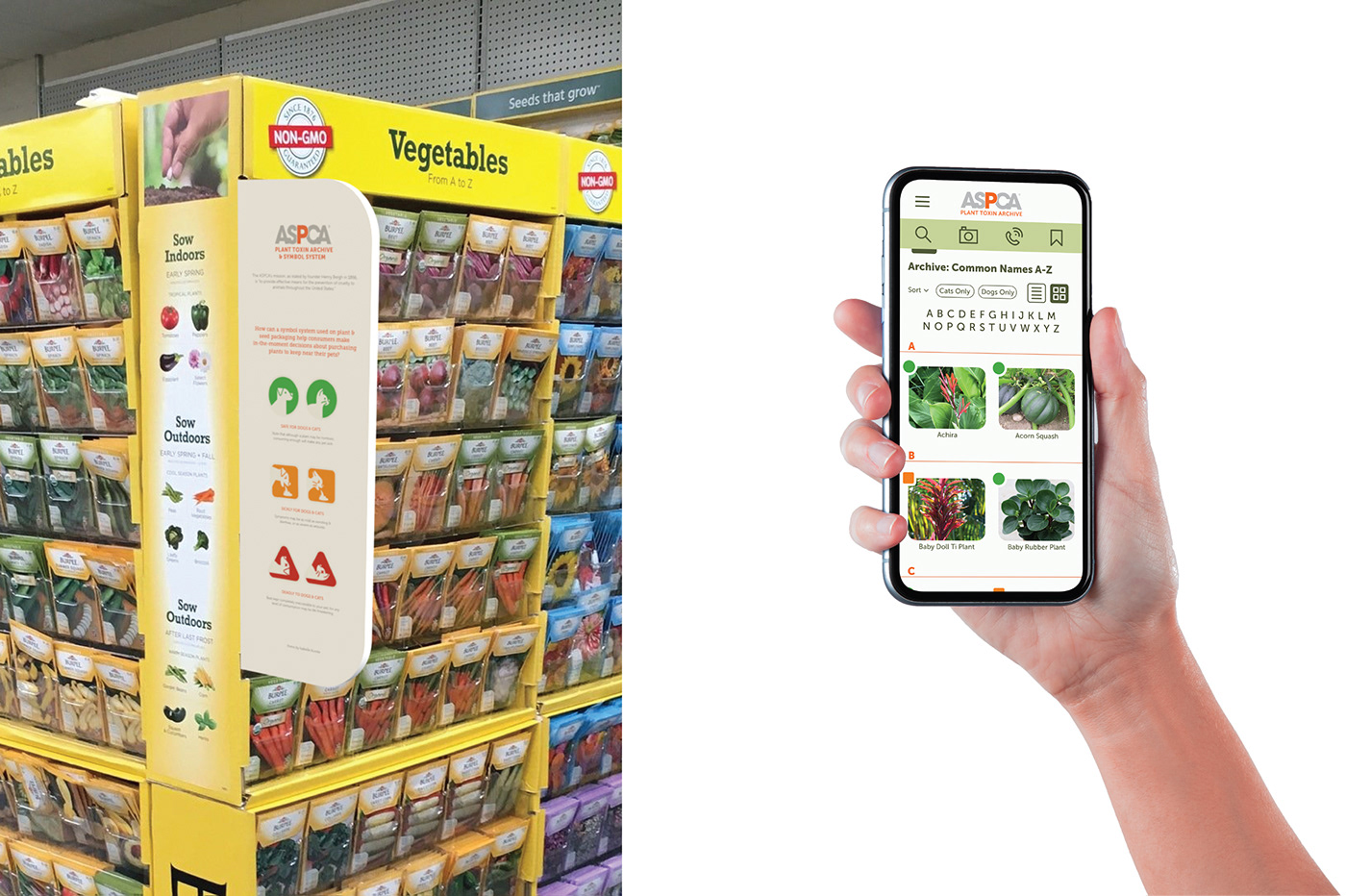
mockup of plant toxin symbol system guide on an in-store promotional poster and mockup of a handheld view of the ASPCA Plant Toxin Archive
REFLECTION
This project involved aspects that were both familiar and challenging. Creating a plant toxicity symbol system came more naturally than designing based on user experience, but I grew a lot as a designer through the process of developing both. I think the symbol system is very effective, although I’m concerned with the vagueness of the Sickly icon since it covers such a wide variety of symptoms, and I wouldn’t want more severe symptoms to be overlooked. In the future I would like to add more educational information on the breakdown of scientific naming as well as other animals reactions to plants. For now, I’m happy with the progress I made and it brings me hope that I could make a project like this reality.
Aicher, O. 1972 Munich Olympic Games. https://www.piktogramm.de/en/
Adlerschmidt communication design. Hochschule für technik und wirtschaft berlin: Markenentwicklung und corporate design [Graphic Design]. Berlin University of Applied Sciences. https://adlerschmidt.de/en/projekte/htw-berlin
American Society for the Prevention of Cruelty to Animals. (2023, January 18). ASPCA. https://www.aspca.org
American Society for the Prevention of Cruelty to Animals. (2022, April 6). Which lilies are toxic to pets? ASPCA. https://www.aspca.org/news/which-lilies-are-toxic-pets.
Austin, Dr. Stephanie. (2022, November 10). Common household plants toxic to dogs. Preventative vet. https://www.preventivevet.com/dogs/common-plants-toxic-to-dogs
Austin, Dr. Stephanie. (2022, November 10). Common household plants toxic to cats. Preventative vet. https://www.preventivevet.com/cats/common-household-plants-toxic-to-cats.
Botanical arts & artists. (2023, January 18). Scientific botanical illustration: How to draw plants to scientific standards. Botanical arts & artists. https://www.botanicalartandartists.com/scientific-botanical-illustration.html
Brownie, C. F. (2022, November). Plants poisonous to animals. Merck manual: Veterinary manual. https://www.merckvetmanual.com/special-pet-topics/poisoning/plants-poisonous-to-animals.
Children’s health queensland hospital and health service. (2005, August). Plants and mushrooms (fungi) poisonous to people. Queensland government. https://www.childrens.health.qld.gov.au/chq/our-services/queensland-poisons-information-centre/plants-mushrooms/.
Gregory, T. (2000). How to write design logos, symbols, and icons. North Light Books.
Huinca, C. (2022). AXA break the myth campaign. https://www.printmag.com/illustration-design/these-clever-insurance-ads-debunk-popular-myths-about-health-wellness/
Huzella, E. (2020). Price we pay poster campaign [Graphic Design/Illustration]. Chapman University student project. https://huzella.myportfolio.com/price-we-pay-poster-campaign
Katzumi, M. & Yamashita, Y. (1964) 1964 Tokyo olympic pictograms [Graphic design]. 1964 Olympic games. https://www.olympic-museum.de/pictograms/olympic-games-pictograms-1964.php.
Luch, A. (2010). Molecular, clinical and environmental toxicology volume 2: Clinical toxicology. Birkhäuser Basel: Imprint: Birkhäuser. https://link.springer.com/content/pdf/10.1007/978-3-7643-8338-1.pdf?pdf=button.
Nagata, A. (2022) Pollinator power [Illustration]. Science moms. https://illoirro.com/science-moms.
Reisen, Jan. (2022, July 1). Poison plants for dogs. American kennel club. https://www.akc.org/expert-advice/home-living/protect-your-pooch-from-poisonous-plants/.
Rosenbaum, S. (1994). 1994 Lillehammer olympic pictograms [Graphic Design]. 1994 Olympic games. https://www.theolympicdesign.com/olympic-design/pictograms/lillehammer-1994/.
Uebele, A. (2007). Signage systems & information graphics: A professional sourcebook. Thames & Hudson.
Ultimate Symbol (1996). Official signs & icons. Ultimate Symbol Inc.
Twyman, M. (1976). The significance of isotype. icographic 10, 2–10. https://www.theicod.org/storage/app/media/resources/Publications/Icographic/ICO_Publications_Icographic_10_full.pdf.
Veterinary medicine library. (2022, May 11). Plants toxic to animals. Illinois library. https://guides.library.illinois.edu/plantstoxictoanimals.
Waller, O. Think pink [Digital Illustration]. Waitrose Magazine. https://www.oliviawaller.co.uk/Waitrose-Magazine-Think-Pink
Washington state university extension master gardener program. (2023, January 24). Poisonous plants and pets. WSU Extension. https://s3.wp.wsu.edu/uploads/sites/2076/2017/07/C094-Poisonous-Plants-17.pdf.
Wyman, L. (2008). Fontainebleau hotel service icons [Graphic design]. Fontainebleau Hotel. http://lancewyman.com/brand-project/fontainebleau-hotel-service-icons/
